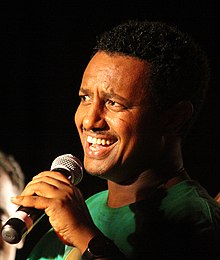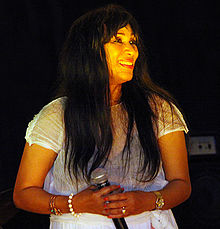Music of Ethiopia
Ethiopian music uses a distinct modal system that is pentatonic, with characteristically long intervals between some notes.
The music of the Ethiopian Highlands uses a fundamental modal system called qenet, of which there are four main modes: tezeta, bati, ambassel, and anchihoy.[1] Three additional modes are variations on the above: tezeta minor, bati major, and bati minor.[2][3][4] Some songs take the name of their qenet, such as tizita, a song of reminiscence.[1] When played on traditional instruments, these modes are generally not tempered (that is, the pitches may deviate slightly from the Western-tempered tuning system), but when played on Western instruments such as pianos and guitars, they are played using the Western-tempered tuning system.
Music in the Ethiopian highlands is generally monophonic or heterophonic.[1] In certain southern areas, some music is polyphonic. Dorze polyphonic singing (edho) may employ up to five parts; Majangir, four parts.[1]
Musical instruments
Chordophones

In the highlands, traditional string instruments include the masenqo (also known as masinko), a one-string bowed lute; the krar (also known as kirar), a six-string lyre; and the begena, a large ten-string lyre.[5] The dita (a five-string lyre)[6] and musical bows (including an unusual three-string variant) are among the chordophones found in the south.[5]
Aerophones
The washint is a bamboo flute that is common in the highlands.[5] Trumpet-like instruments include the ceremonial malakat used in some regions, and the holdudwa (animal horn; compare shofar) found mainly in the south.[5] Embilta flutes have no finger holes, and produce only two tones, the fundamental and a fourth or fifth interval.[5] These may be metal (generally found in the north) or bamboo (in the south).[5] The Konso and other people in the south play fanta, or pan flutes. It has 6 holes.
Idiophones
In the Ethiopian Orthodox Church, liturgical music employs the senasel, a sistrum.[5] Additionally, the clergy will use walking stick, called mequamia,[7] to maintain rhythm.[5] Rural churches historically used a dawal to call the faithful to prayer. They are made from stone slabs or pieces of wood.[5] The Beta Israel use a small gong called a qachel as liturgical accompaniment, though qachel may also refer to a small bell.[5] The toom, a lamellophone, is used among the Nuer, Anuak, Majangir, Surma, and other Nilotic groups.[5] Metal leg rattles are common throughout the south.[5]
Membranophones
The kebero is a large hand drum used in the Orthodox Christian liturgy.[5] Smaller kebero drums may be used in secular celebrations.[5] The nagarit, played with a curved stick, is usually found in a secular context such as royal functions or the announcement of proclamations, though it has a liturgical function among the Beta Israel.[5] The Gurage and certain other populations in the lowlands commonly play the atamo, a small hand drum sometimes made of clay.[5] In Gambela region in western Ethiopia, the Anuak specify three different kinds of drums: the anedo (small drum), the odola (medium drum), and the bul (big drum), with different rhythmic patterns attached to certain song genres.[8]
Religious and secular music
Some Ethiopian religious music has an ancient Christian element, traced to Yared, who lived during the reign of Emperor Gebre Meskel who ruled for 14 years during Zagwe dynasty. In northeastern Ethiopia, in Wollo, a Muslim musical form called manzuma developed. Sung in Amharic, manzuma has spread to Harar and Jimma, where it is now sung in the Oromo language. In the Ethiopian Highlands, traditional secular music is played by mostly itinerant musicians called azmaris, who are regarded with respect in Ethiopian society.[citation needed]
Popular music
Ethiopia is a musically traditional country. Popular music is played, recorded and listened to, but most musicians also sing traditional songs, and most audiences choose to listen to both popular and traditional styles. A long-standing popular musical tradition in Ethiopia was that of brass bands, imported from Jerusalem in the form of forty Armenian orphans (Arba Lijoch) during the reign of Haile Selassie. This band, which arrived in Addis Ababa on September 6, 1924, became the first official orchestra of Ethiopia. By the end of World War II, large orchestras accompanied singers; the most prominent orchestras were the Army Band, Police Band, and Imperial Bodyguard Band.
From the 1950s to the 1970s, Ethiopian popular musicians included Mahmoud Ahmed, Alemayehu Eshete, Hirut Bekele, Ali Birra, Ayalew Mesfin, Kiros Alemayehu, Muluken Melesse and Tilahun Gessesse, while popular folk musicians included Alemu Aga, Kassa Tessema, Ketema Makonnen, Asnaketch Worku, and Mary Armede. Perhaps the most influential musician of the period, however, was Ethio-jazz innovator Mulatu Astatke. Amha Records, Kaifa Records, and Philips-Ethiopia were prominent Ethiopian record labels during this era. Since 1997, Buda Musique's Éthiopiques series has compiled many of these singles and albums on compact disc.
During the 1980s, the Derg controlled Ethiopia, and emigration became almost impossible. Musicians during this period included Ethio Stars, Walias Band and Roha Band, though the singer Neway Debebe was most popular. He helped to popularize the use of seminna-werq (wax and gold, a poetic form of double entendre) in music (previously only used in qiné, or poetry) that often enabled singers to criticize the government without upsetting the censors.
Contemporary scene

Currently the most prominent Ethiopian singer internationally is Gigi. Through her performing with prominent jazz musicians such as Bill Laswell (who is also her husband) and Herbie Hancock, Gigi has brought Ethiopian music to popular attention, especially in the United States, where she now lives.
Another noteworthy singer is Neway Debebe, who was very popular among the youth of the 1980s and early 1990s with such songs as "Yetekemt Abeba," "Metekatun Ateye," "Safsaf," and "Gedam" - among others. Abatte Barihun has exemplified all four main qenets on his 2005 album Ras Deshen.[3]
Éthiopiques producer Francis Falceto criticizes contemporary Ethiopian music for eschewing traditional instruments and ensemble playing in favor of one-man bands using synthesizers.[9] Harvard University professor Kay Kaufman Shelemay, on the other hand, maintains that there is genuine creativity in the contemporary music scene.[10] She further points out that Ethiopian music is not alone in shifting to electronically produced music, a point that Falceto acknowledges.[9][10]

In the West, several bands were also created in recent years to play music inspired by the Éthiopiques series and other examples of Ethiopian music of the '60s and '70s. They include Boston's Either/Orchestra,[11] Imperial Tiger Orchestra (Switzerland),[12] and Le Tigre des platanes (France).[13]
New genres of music, popular in western countries, such as EDM, rock and hip hop have been introduced in recent years. Musical acts like Jano Band play a new style of music dubbed "Ethio-rock", a mix of Ethiopian music and rock music.[14] Hip hop music started influencing Ethiopian music in the early to mid 2000s and culminated with the creation of Ethiopian hip hop, rhymed in the native Amharic language. The Earliest and most influential rappers of Ethiopian hip hop were Teddy Yo and Lij Michael, with the latter being more commercially successful.[15] The success of both Jano Band and Lij Michael led to their inclusion in the 2017 edition of Coke Studio Africa[14]
In 2018, a young artist named Rophnan introduced the country to his own version of electronic dance music, winning the album of the year award and changing the mainstream music scene further.[16]
References
- ^ a b c d Shelemay, Kay Kaufman (2001). "Ethiopia". In Sadie, Stanley; Tyrrell, John (eds.). The New Grove Dictionary of Music and Musicians. Vol. viii (2nd ed.). London: Macmillan. p. 356.
- ^ Frangou, Chris. "Common Ethiopian Pentatonic Scales or Qenet (ቅኝት woyesa)".
{{cite journal}}: Cite journal requires|journal=(help) - ^ a b Abatte Barihun, liner notes of the album Ras Deshen, 200.
- ^ Abate, Ezra. "Ethiopian Kiñit (scales): Analysis of the formation and structure of the Ethiopian scale system" (PDF). Proceedings of the 16th International Conference of Ethiopian Studies. Archived from the original (PDF) on 2018-09-20. Retrieved 2020-04-10.
- ^ a b c d e f g h i j k l m n o p Shelemay, pp. 355–356
- ^ Ethiopian Traditional Music Instruments (on Mekatecha - Tigrina Language News and Culture website)
- ^ Playing the maqwamiya, senasel and kebero explained (youtube)
- ^ "Musical Instruments". Songs from Ethiopia and South Sudan. 2019-01-10. Retrieved 2019-01-10.
- ^ a b Eyre, Banning (2005-12-18). "Francis Falceto - Ethiopia: Diaspora and Return (interview)". Afropop Worldwide. World Music Productions. Archived from the original on September 27, 2007. Retrieved March 10, 2007.
- ^ a b Eyre, Banning (2006-09-15). "Kay Kaufman Shelemay - Ethiopia: Diaspora and Return (interview)". Afropop Worldwide. World Music Productions. Archived from the original on October 25, 2007. Retrieved March 10, 2007.
- ^ Roger Levesque (November 13, 2012). "Either/Orchestra brings African Sound to Edmonton". Edmonton Journal.
- ^ Denselow, Robin (12 January 2012). "Imperial Tiger Orchestra – review". The Guardian. Retrieved 2013-03-02.
- ^ Queille Dominique (December 19, 2007). "Le Tigre des Platanes fait ses griffes à Africolor". Libération.
- ^ a b "Jano Band takes Ethio-rock to Coke Studio Africa".
- ^ Nyanga, Caroline. "Tanzania's Yamoto band in Kenya for a collaboration with Ethiopia's Lij Michael". Standard Digital News. Retrieved 2017-08-26.
- ^ https://www.thereporterethiopia.com/article/rophnan-shines-leza-awards-night
